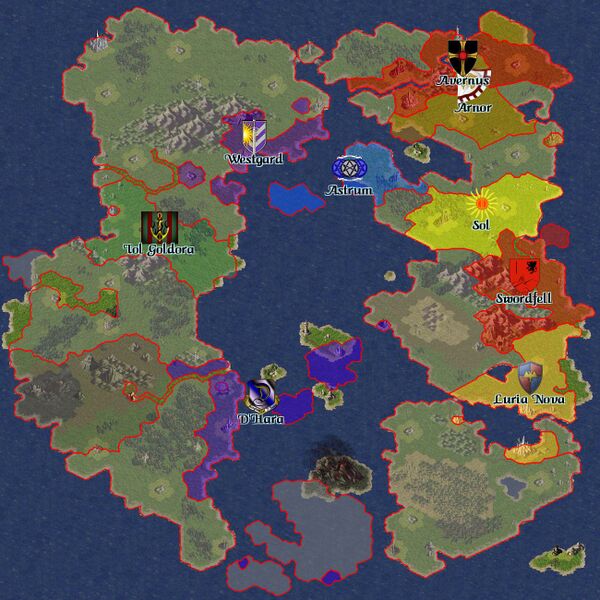Dwilight/Fellish
Fellish is one of the younger cultures on Dwilight and therefore has known but few realms adhering to this culture:
Ironically after the fall of Wicrose, it became the only culture with more than one realm: Swordfell and Tol Goldora. The culture reached its height after the Golden Farrow Accords, when Sol was alive as well and all three Fellish realms were of respectable size. The history of Fellish culture is, however, a complex one.
The native Fellish had once inhabited almost the entire Toprak, but lost much of their territory during the Gunthor invasion. As such the Easterners viewed the Fellish as being one of the lesser Dwili tribes and did not pay much heed to them. And although it can be argued that D'Hara or Aquilegia could be considered Fellish realms, they were much closer to the Morekians and Madinese: having Fellish inhabitants, but adhering the Eastern culture.
Nevertheless, Aquilegia should be seen as an important development in Fellish culture. First of all, in order to legitimize their independence the Aquilegians were very interested in the history of the local people and were actually the first to recognize that the Flow Dwili belonged to larger cultural area, which once had extended all the way north with the Fallans. Secondly the Astromancy War suggested that theocracies might be less fitting for the 'less civilized' people.
After the destruction of Aquilegia, the Morek Empire wanted to organize a new realm in the area. When Luria Nova heard of it, they offered the Divide Mountains, hoping this border realm would serve as a buffer between them and the Morek Empire. Despite the Lurian influence, Swordfell calling itself Fellish and Swordfell being a republic, Swordfell in its early stage should be considered Morekian. This is because in the first place it was a Morekian colony, but also because the Lurian influence became severely limited after the Lurian tyrant Sevastian Guile was deposed. Also Fellish should be considered much more a political term than a cultural one: the term indicated the intention of Swordfell to rule the lands inhabited by native Fellish.
However, during the First Continental War, Swordfell sided with the anti-theocratic republicans and as such left the Morekian sphere of influence, while entering the one of Luria Nova. It was with the help of Swordfell that Luria Nova survived the Invasion War, but due to the conservative nature of Lurian culture, Swordfell never became fully Lurianized, thus giving birth to a new culture: Fellish.
Rakjak
The Rakjak live on the southern part of the Great Plain of Toprak and actually were the ruling class of Swordfell for many years. As such they heavily influenced the development of Fellish culture. It should be noted that the Rakjak consider themselves Morekians and that they still do, even though they consider them Fellish as well. Again: in their eyes one is cultural, while the other is political.
After freeing Westfold, the Rakjak formed a new realm with Unterwood and named it Sol in honor of the Duchy in the Divide Mountains, which stood up against the tyrant Sevastian Guile. As masters of Sol, the Rakjak were also a major influence in its colony Tol Goldora. However, after the fall of Sol, Swordfell became more urbanized and the influence of the Rakjak has waned ever since.
Solans
At the formation of Swordfell, it was agreed upon that its capital would be the Balance's Retreat. This area was native to the Zatyty, but they were ruled over by Solaria, which was a Lurian realm. There intermingling gave rise to the Solan culture. The Duchy even returned to Luria Nova when it was dissatisfied with tyrant Sevastian Guile, but was commanded to return to Swordfell. This resulted in pro-Lurian feelings within Swordfell, which would ever be fostered by the people of the Divide Mountains.
Chersonisians
The inhabitants of the Flow Peninsula have always played a secondary role within the politics of Swordfell, serving more as tie-breaker between the Rakjak and the Solans than as a seperate party. However, they were the reason for the name Fellish and also had the largest population. This has resulted in an increased influence during the latter years - especially after the collapse of Sol. But since Chersonisians do not seem to care much about politics, this influence is mainly economically.
Unter
The Unterwood was controlled by Corsanctum, which has a hard time to civilize the local Unter, who were native Fellish like the Chersonisians. During the Invasion War the forest saw an influx of Asylonians. Although Asylon was defeated and then moved on to Luria Nova, many Asylonians remained behind, intermingling with the Unter. This mixture would result in a desire to resettle the Occidens and prove essential for the survival of Tol Goldora. The Unter would know an independent realm for a time in Westfold, but were defeated by Astrum.
Tol Goldorans
The Asylonians in Unterwood desired to return to the Occidens, so Sol decided to establish a colony in Golden Farrow. It would not only attract Asylonians, but also many other Fellish who had heard of the riches in the west - most of them were Unter who had lived with the Asylonians. At its conception, Tol Goldora was immediately ousted by Westgard, but the Asylonians knew the land and lead the Tol Goldorans to Via, where they would be able to make their stand against Westgard. After a fierce fight, Tol Goldora regained Golden Farrow with the Golden Farrow Accords.
After the Zuma Plague there was a rift between traditionalists, who wanted to remain in the area, and the progressives, who wanted to sail the seas. In the end the progressives got the upper hand and Tol Goldora migrated to the Virovene. Here they intermingled with the local Morekian populace, whose influence would eventually make Tol Goldora decide to become a theocracy to bolster its claim to the land.
